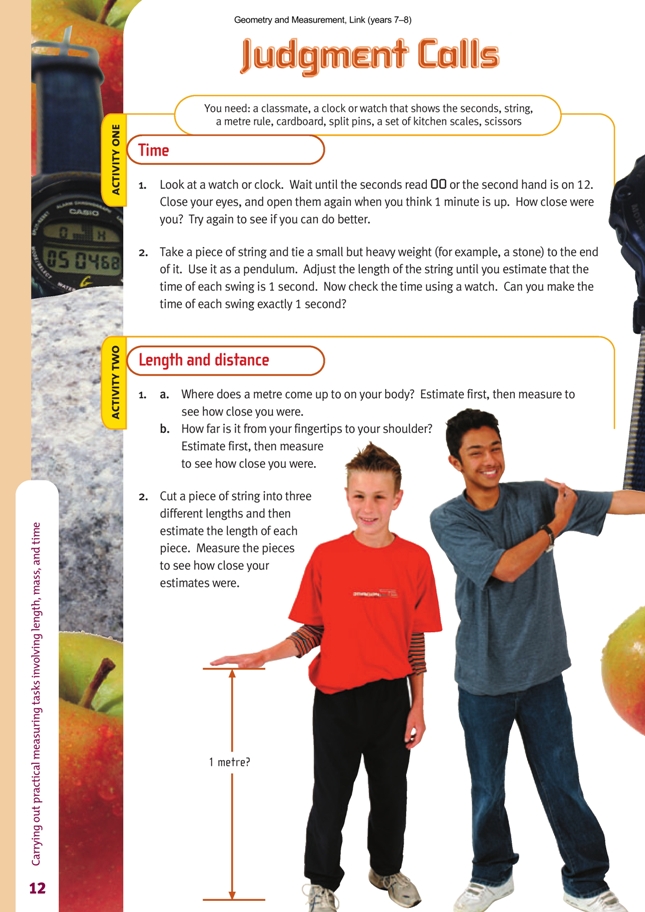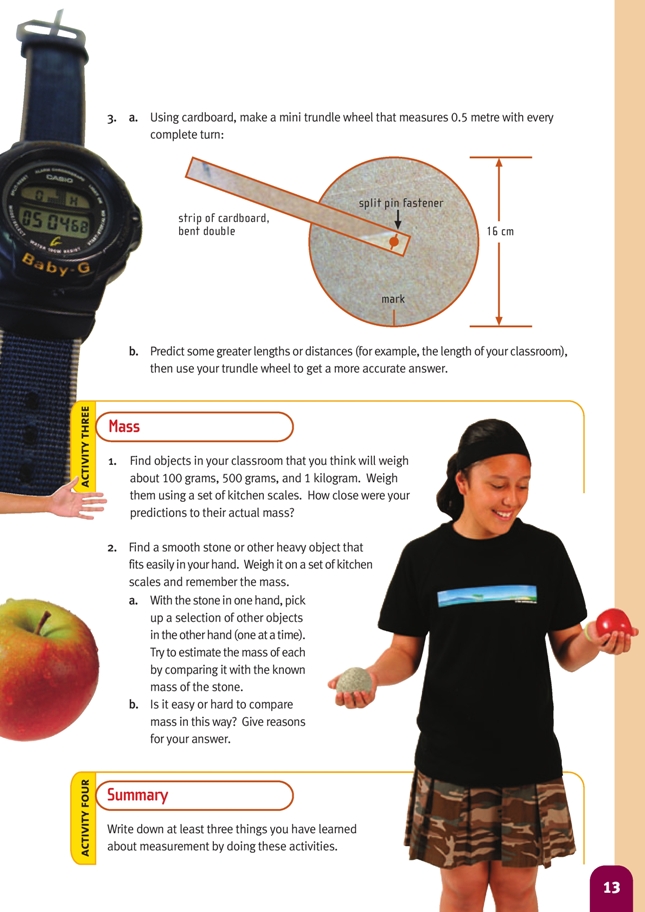This is a level 3 link measurement activity from the Figure It Out series.
Click on the image to enlarge it. Click again to close. Download PDF (829 KB)
estimate measurements
carry out practical measuring tasks involving time, length, mass
clock or watch that shows the seconds
classmate
a metre ruler
string, cardboard, spilt pins, scissors
a set pf kitchen scales
This activity gives students opportunities to estimate and measure time, length, and weight (mass). It is designed to help them develop mental benchmarks for measures such as a minute, a metre, or a kilogram. Such benchmarks are a great help when making estimates. Using a benchmark, we can work from the known to the unknown with a good level of confidence instead of relying on pure guesswork. Here is an example of reasoning from a benchmark: “I know that it’s a metre up to my armpit, and the width of this table is about three-quarters of that length, so it must be about 75 cm wide.”
Your students are likely to be confused about the difference between estimate and guess because the two words are often used interchangeably as in “guess/estimate the number of jellybeans in the jar”. But when we use the word in a maths context, estimate always involves making a calculation of some kind, based on benchmarks/experience and simplified numbers. The difference can be seen in this example: “I’m thinking of a number between 1 and 9. Guess my number.” No kind of calculation is going to help in a situation like this, so “guess” is the right word. “Guess the height of that building” is an invitation to pluck a number out of the air; “Estimate the height of that building” is a challenge to do some calculating.

Activity One
After the students doing question 1 have tried estimating 1 minute, talk about the techniques used by group members to keep track of the time. Some will have relied totally on “feeling” the passage of time. Others may have learned techniques such as counting to themselves: “1 crocodile, 2 crocodiles, 3 crocodiles ...” or moving their finger up and down their forearm 60 times. Ask “What technique gave the best result? Would it give the same result another time?”
After the discussion, let everyone make a second attempt at judging 1 minute. Students can use the same technique as before or try one that someone else has suggested. You could let them have several more attempts and then get them to graph their times so that they can be easily compared. Ask “Are your estimates
getting more accurate with practice?”
Question 2 involves a pendulum. The frequency of a pendulum is determined mostly by the length of the string. The mass of the weight and the angle at which it is released have little or no effect. Allow your students to experiment with the variables as they try to get their pendulum to swing at the right rate. Suggest that they alter just one variable at a time so that the effect of the change can be observed.
Students may want to know why it is that their pendulum always slows down and comes to a stop. The main reason is air resistance.
Activity Two
Questions 1 and 2 are part prediction and part benchmarking. If students can find and remember a place on their body that is 1 metre above the ground, they can use this as a reference (until they grow!) when making estimates.
Encourage your students to try other measurements, such as their outstretched handspan, elbow to wrist, elbow to fingertip, width of thumb, length of a single pace, and so on. If they can discover a couple that are convenient and easy to remember (for example, a student might find that their handspan is 20 cm), they should memorise these and use them when estimating. They will also be useful when it comes to recognising unlikely or foolish answers to calculations.
The first two questions in Activity Two involve small lengths. Question 3 is about bigger lengths.
Students should use the information from their first trundle wheel measurements to help with subsequent estimates; for example, “I know that the length of the classroom is 12 m. The playground is about three classrooms long, so I estimate that it must be about 36 m in length.” Again, it is a good idea if students can develop some benchmarks for use when estimating longer distances: measure and talk about what 5 and 10 m look like, and make use of measured distances such as the local swimming pool (25 m), the sprint track (100 m), and the relay track (400 m). Some even longer benchmarks are handy: “Use a map to work out points that are a kilometre from school, how far it is from our school to our town or city centre, and the distance
from our town to the next nearest town.”
Activity Three
This activity will help students establish benchmarks for mass by identifying objects of particular masses and will give them practice at estimating mass by comparing objects with a known mass.
Activity Four
This is a useful question to promote reflective thinking and is also a valuable assessment opportunity. Get each student to write their three things on a coloured piece of paper and then put these up as a display. This display will be useful for reference and reinforcement as you come back to it over the following days.
Challenge students to memorise and use their benchmarks to make estimates during the week and have them report back to the group on their experiences next session.
Answers to Activities
Activity One
1.–2. Practical activities
Activity Two
1.–3. Practical activities
Activity Three
1. Practical activity
2. a. Practical activity
b. Answers will vary. You may find that it is
reasonably easy to compare the mass of objects
of similar density, like two stones, but not so
easy where the densities are quite different.
Activity Four
Answers will vary.

